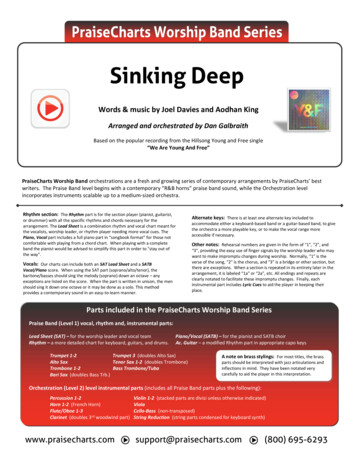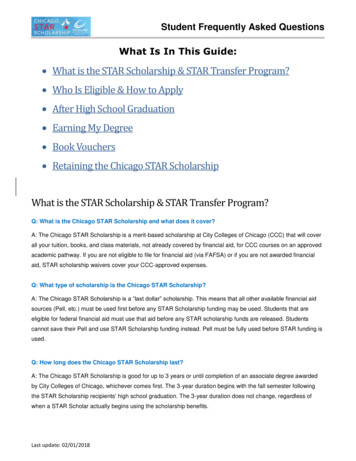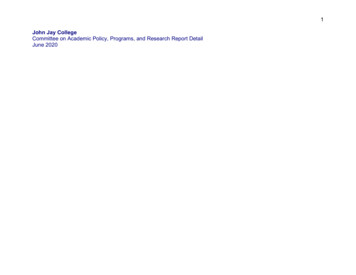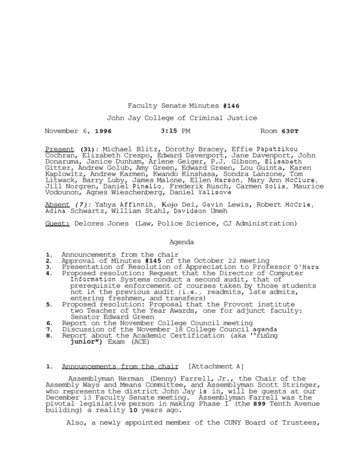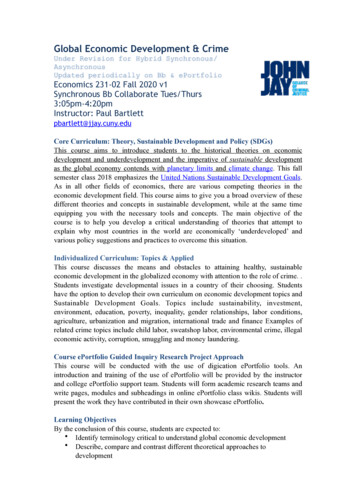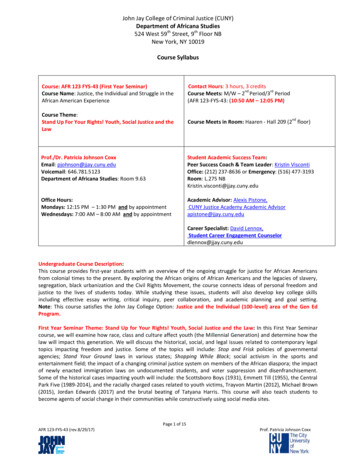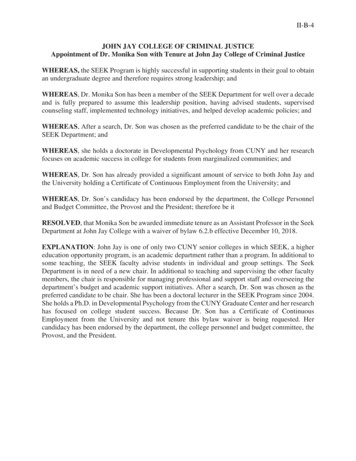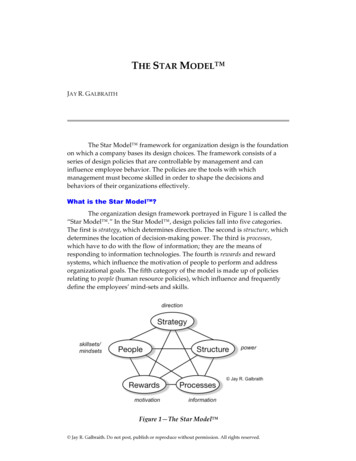
Transcription
THE STAR MODEL JAY R. GALBRAITHThe Star Model framework for organization design is the foundationon which a company bases its design choices. The framework consists of aseries of design policies that are controllable by management and caninfluence employee behavior. The policies are the tools with whichmanagement must become skilled in order to shape the decisions andbehaviors of their organizations effectively.What is the Star Model ?The organization design framework portrayed in Figure 1 is called the“Star Model .” In the Star Model , design policies fall into five categories.The first is strategy, which determines direction. The second is structure, whichdetermines the location of decision-making power. The third is processes,which have to do with the flow of information; they are the means ofresponding to information technologies. The fourth is rewards and rewardsystems, which influence the motivation of people to perform and addressorganizational goals. The fifth category of the model is made up of policiesrelating to people (human resource policies), which influence and frequentlydefine the employees’ mind-sets and skills.Figure 1—The Star Model Jay R. Galbraith. Do not post, publish or reproduce without permission. All rights reserved.
JAY R. GALBRAITHTHE STAR MODEL 2StrategyStrategy is the company’s formula for winning. The company’sstrategy specifies the goals and objectives to be achieved as well as the valuesand missions to be pursued; it sets out the basic direction of the company. Thestrategy specifically delineates the products or services to be provided, themarkets to be served, and the value to be offered to the customer. It alsospecifies sources of competitive advantage.Traditionally, strategy is the first component of the Star Model to beaddressed. It is important in the organization design process because itestablishes the criteria for choosing among alternative organizational forms.(See the book, Designing Dynamic Organizations by Galbraith, Downey andKates, published by Jossey-Bass in 2002, for tools to help translate strategyinto criteria.) Each organizational form enables some activities to beperformed well, often at the expense of other activities. Choosingorganizational alternatives inevitably involves making trade-offs. Strategydictates which activities are most necessary, thereby providing the basis formaking the best trade-offs in the organization design. Matrix organizationsresult when two or more activities must be accomplished without hinderingthe other. Rather than choosing the “or,” matrix requires an embracing of the“and.” Companies want to be global and local.StructureThe structure of the organization determines the placement of powerand authority in the organization. Structure policies fall into four areas: Specialization Shape Distribution of power DepartmentalizationSpecialization refers to the type and numbers of job specialties used inperforming the work. Shape refers to the number of people constituting thedepartments (that is, the span of control) at each level of the structure. Largenumbers of people in each department create flat organization structures withfew levels. Distribution of power, in its vertical dimension, refers to the classicissues of centralization or decentralization. In its lateral dimension, it refers tothe movement of power to the department dealing directly with the issuescritical to its mission. Departmentalization is the basis for forming departmentsat each level of the structure. The standard dimensions on which departmentsare formed are functions, products, workflow processes, markets, customers Jay R. Galbraith. Do not post, publish or reproduce without permission. All rights reserved.
JAY R. GALBRAITHTHE STAR MODEL 3and geography. Matrix structures are ones where two or more dimensionsreport to the same leader at the same level.ProcessesInformation and decision processes cut across the organization’sstructure; if structure is thought of as the anatomy of the organization,processes are its physiology or functioning. Management processes are bothvertical and horizontal.Figure 2—Vertical processesVertical processes, as shown in Figure 2 allocate the scarce resources offunds and talent. Vertical processes are usually business planning andbudgeting processes. The needs of different departments are centrallycollected, and priorities are decided for the budgeting and allocation of theresources to capital, research and development, training, and so on. Thesemanagement processes are central to the effective functioning of matrixorganizations. They need to be supported by dual or multidimensionalinformation systems.Figure 3—Lateral ProcessesHorizontal–also known as lateral–processes, as shown in Figure 3, aredesigned around the workflow, such as new product development or theentry and fulfillment of a customer order. These management processes arebecoming the primary vehicle for managing in today’s organizations. Lateralprocesses can be carried out in a range of ways, from voluntary contactsbetween members to complex and formally supervised teams. Jay R. Galbraith. Do not post, publish or reproduce without permission. All rights reserved.
JAY R. GALBRAITHTHE STAR MODEL 4RewardsThe purpose of the reward system is to align the goals of the employeewith the goals of the organization. It provides motivation and incentive forthe completion of the strategic direction. The organization’s reward systemdefines policies regulating salaries, promotions, bonuses, profit sharing, stockoptions, and so forth. A great deal of change is taking place in this area,particularly as it supports the lateral processes. Companies are nowimplementing pay-for-skill salary practices, along with team bonuses or gainsharing systems. There is also the burgeoning practice of offering nonmonetary rewards such as recognition or challenging assignments.The Star Model suggests that the reward system must be congruentwith the structure and processes to influence the strategic direction. Rewardsystems are effective only when they form a consistent package incombination with the other design choices.PeopleThis area governs the human resource policies of recruiting, selection,rotation, training, and development. Human resource policies – in theappropriate combinations – produce the talent required by the strategy andstructure of the organization, generating the skills and mind-sets necessary toimplement the chosen direction. Like the policy choices in the other areas,these policies work best when they are consistent with the other connectingdesign areas.Human resource policies also build the organizational capabilities toexecute the strategic directions. Flexible organizations require flexible people.Cross-functional teams require people who are generalists and who cancooperate with each other. Matrix organizations need people who can manageconflict and influence without authority. Human resource policiessimultaneously develop people and organizational capabilities.Implications of the Star Model As the layout of the Star Model illustrates, structure is only one facetof an organization’s design. This is important. Most design efforts invest fartoo much time drawing the organization chart and far too little on processesand rewards. Structure is usually overemphasized because it affects statusand power, and a change to it is most likely to be reported in the businesspress and announced throughout the company. However, in a fast-changingbusiness environment, and in matrix organizations, structure is becoming lessimportant, while processes, rewards, and people are becoming moreimportant. Jay R. Galbraith. Do not post, publish or reproduce without permission. All rights reserved.
JAY R. GALBRAITHTHE STAR MODEL 5Another insight to be gained from the Star Model is that differentstrategies lead to different organizations. Although this seems obvious, it hasramifications that are often overlooked. There is no one-size-fits-allorganization design that all companies–regardless of their particular strategyneeds–should subscribe to. There will always be a current design that hasbecome “all the rage.” But no matter what the fashionable design is–whetherit is the matrix design or the virtual corporation–trendiness is not sufficientreason to adopt an organization design. All designs have merit but not for allcompanies in all circumstances. The design, or combination of designs, thatshould be chosen is the one that best meets the criteria derived from thestrategy.A third implication of the Star Model is in the interweaving natureof the lines that form the star shape. For an organization to be effective, all thepolicies must be aligned and interacting harmoniously with one another. Analignment of all the policies will communicate a clear, consistent message tothe company’s employees.The Star Model consists of policies that leaders can control and thatcan affect employee behavior, as suggested in Figure 4. It shows thatmanagers can influence performance and culture, but only by acting throughthe design policies that affect behavior.Figure 4 — How Organization Design Affects Behavior and Culture Jay R. Galbraith. Do not post, publish or reproduce without permission. All rights reserved.
JAY R. GALBRAITHTHE STAR MODEL 6Overcoming Negatives Through DesignOne of the uses of the Star Model is to use it to overcome thenegatives of any structural design. That is, every organizational structureoption has positives and negatives associated with it. If management canidentify the negatives of its preferred option, the other policies around theStar Model can be designed to counter the negatives while achieving thepositives.Centralization can be used as an example. When the internet becamepopular, many units in some organizations began their own initiatives torespond to it. These organizations experienced the positives ofdecentralization. They achieved speed of action, involvement of peopleclosest to the work and tailoring of the application to the work of the unit.They also experienced the negatives of decentralization. The many initiativesduplicated efforts and fragmented the company's response. There weremultiple interfaces for customers and suppliers. They ran into difficulty inattracting talent and sometimes had to settle for less than top people.Most companies have responded by centralizing the activitiessurrounding the internet into a single unit. In so doing, they have reducedduplication, achieved scale economies and presented one face to the customer.They have combined many small internet units into one large one which isattractive for professional internet managers. But at the same time, decisionmaking moves farther from the work, the central unit becomes an internalmonopoly and the result can be lack of responsiveness to other organizationaldepartments who are using the internet.To minimize the negatives of the central unit, the management of thecompany can design the appropriate processes, rewards and staffing policies.For example in the planning process, the central unit can present its plan toservice the rest of the organization. The leadership team can debate the planand arrive at an approved level of service. The plan can be prepared bypeople from the central unit and a horizontal team of people from throughoutthe company. Along with its goals of reducing duplications and achievingscale, the central unit will also be expected to meet the planned service levelsthat were agreed. The central unit's performance will be measured andrewarded on the basis of meeting planned goals. And finally to keep thecentral unit connected to the work, it can be staffed by a mix of permanentprofessionals and rotating managers from the rest of organization on one ortwo year assignments. This complete design increases the chances that thecentral unit will achieve its positives while minimizing the usual negatives. Jay R. Galbraith. Do not post, publish or reproduce without permission. All rights reserved.
JAY R. GALBRAITH THE STAR MODEL 2 Jay R. Galbraith. Do not post, publish or reproduce without permission. All rights reserved. Strategy Strategy is the company .
